For the last decade, the Maria S. Merian (MSM) has been making ripples in oceans around the globe. Late last month, Halifax welcomed one of the worldтs most efficient seagoing research platforms to Pier 24 for a port call, and the opportunity for a first-hand glimpse at how ocean research is done in the Labrador Sea.
The Open Ship event on August 22 was hosted by the captain and crew of the MSM. The visit was sparked by the strong relationships that аТМгЦТСљКЯВЪПЊНБжБВЅ researchers have been building with German colleagues. Theses relationships have grown stronger since German Chancellor Angela Merkel came to аТМгЦТСљКЯВЪПЊНБжБВЅ in 2012 and the Canada-Germany partnership in ocean science gained momentum.
Visitors were invited to tour some of the shipтs laboratories, bridge and main decks. They were also able to get a closer look at ocean research technology, as well as informative displays and handouts to enrich their understanding of the research conducted on the MSM.
More than 1,000 members of the public toured the ship, and the following evening scientists, government officials, industry partners and university leadership were invited to a reception.
While certain sections of the ship were off-limits to the public, the MSM in its entirety boasts 14 laboratories and is host to 23 crew members and 23 scientists, technicians and students.
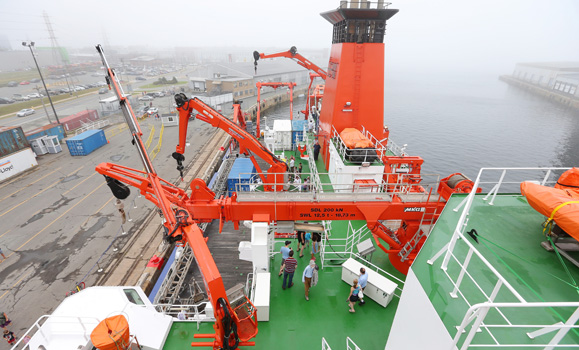
A view from above.
Studying climate change through the ocean
The MSMтs most recent scientific expedition, MSM 45, took place under the direction of Chief Scientist Ralph Schneider, director of the Center of Interdisciplinary Marine Sciences at Kiel University in Germany. Throughout the three-week voyage from Nuuk, Greenland to Halifax, Nova Scotia, Dr. Schneider applied his knowledge as a marine geologist and expert in paleoclimate research to oversee all of the scientistsт daily work and ensure successful execution of the overall mission.
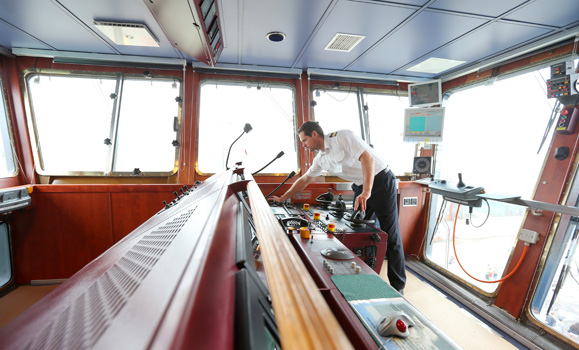
Crew of Maria S. Merian on the ship's bridge.
тWhat weтre interested in is how natural climate variability has affected the Labrador Sea in terms of climate change and ecosystem response, not only at the surface but also in the deep sea,т says Dr. Schneider. тWe want to know how all these different compartments interact in terms of change: is it the atmosphere leading the ocean circulation or is it ocean circulation affecting the atmosphere?т
To answer these questions, Dr. Schneider and the other researchers on board collected and analyzed sediment from the Labrador Sea to paint a historical record that covers up to the last 10,000 years and resolves this time span in a resolution of a few decades to centuries.
тThe better the records, the better the research and our knowledge is about the climate system and the impact of it,т says Dr. Schneider. тItтs a very complex system. Itтs not the sea alone, but itтs all these different factors working together.т
As guests on board MSM 45, аТМгЦТСљКЯВЪПЊНБжБВЅтs Markus Kienast and students Stefanie Mellon and Irena Schulten contributed to the overall mission.
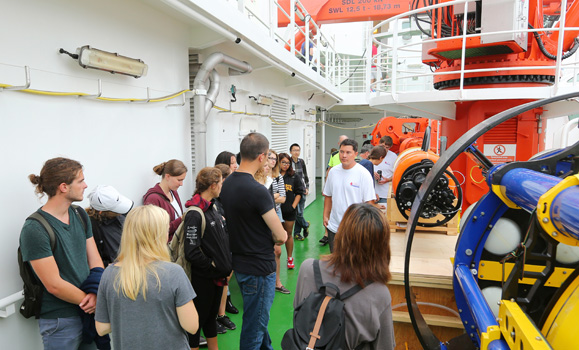
Paul Chua from Scripps Institute of Oceanography (in white) leads a tour.
Collaboration between nations
While the value of the research speaks for itself, the Open Ship event also highlighted аТМгЦТСљКЯВЪПЊНБжБВЅтs role making ocean sciences in Canada an international venture. The collaborative nature of two nations is increasing the knowledge and understanding of the critical North Atlantic region of the World Ocean. Ь§
Mellon, whoтs recently completed a combined honours co-op in Ocean Science and Environmental Science, can attest to this cooperation through her personal experience on board MSM 45.
тOne of the more surprising things I learned while spending time with a group of German scientists was how much more valued ocean science is in Germany, compared to Canada,т Mellon says. тAs Canadians, I think itтs important that we fund ocean research, as we border three major oceans and possess the largest coastline of any country.т
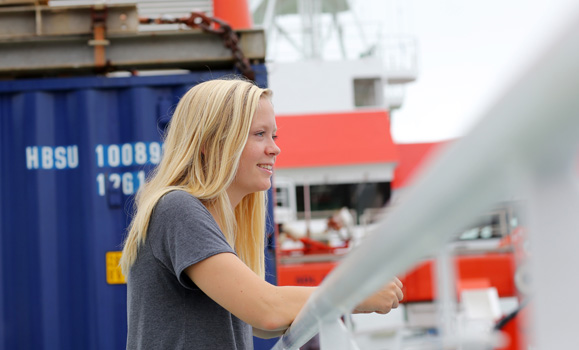
Stephanie Mellon, аТМгЦТСљКЯВЪПЊНБжБВЅ Oceanography student who participated in the MSM 45 research cruise.
Continued research
When the ship left Halifax, it began its 46th research expedition back to the Labrador Sea and other areas of the North Atlantic. Led by Dr. Falk Pollehne from the Leibniz Institute for Baltic Sea Research, WarnemУМnde, the MSM 46 expedition will be another collaboration of German-made research infrastructure and Canadian-built, internationally developed technology, .
As guests on board MSM 46, members of Canada Excellence Research Chair Dr. Doug Wallaceтs team have long been waiting for the deployment of the SeaCycler in Labrador Sea. The research platform was designed specifically for high-energy, dynamic open ocean environments where extreme weather and wave conditions pose almost insurmountable challenges to other research platforms. Built with durability and longevity in mind, the SeaCycler will collect real-time data for 365 days. This will help scientists learn more about the тbreathing processт that happens in the areaтsending oxygen and, in recent years, fossil fuel carbon dioxide from the atmosphere to deep layers of the ocean all around the world. Ь§
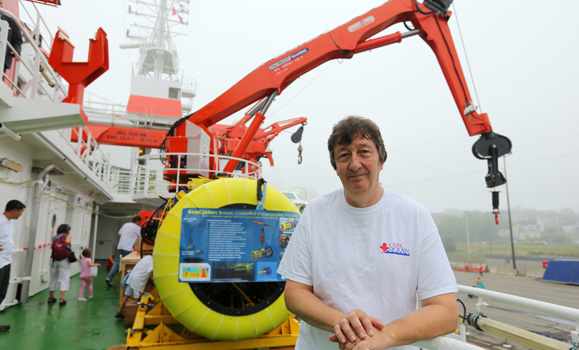
Doug Wallace, Canada Excellence Research Chair in Ocean Science and Technology, with SeaCycler.
The deployment of the SeaCycler is part of the Canada-wide Natural Sciences and Engineering Research Council of Canadaтs VITALS project. The original idea for the SeaCycler was born at the Bedford Institute of Oceanography (BIO), while the owner of its prototype and partner in its development is the Scripps Institute of Oceanography in San Diego, California. The аТМгЦТСљКЯВЪПЊНБжБВЅ-BIO-Scripps consortium hopes to continue development and deployment of the unique technology in additional key locations in conjunction with German partners.
аТМгЦТСљКЯВЪПЊНБжБВЅтs Stephanie Kienast is also on board MSM 46, with her research contributing to the overall scientific mission of examining the changes in the Labrador Sea from the period before heavy human impacts on the environment to the present day.
Ь§

